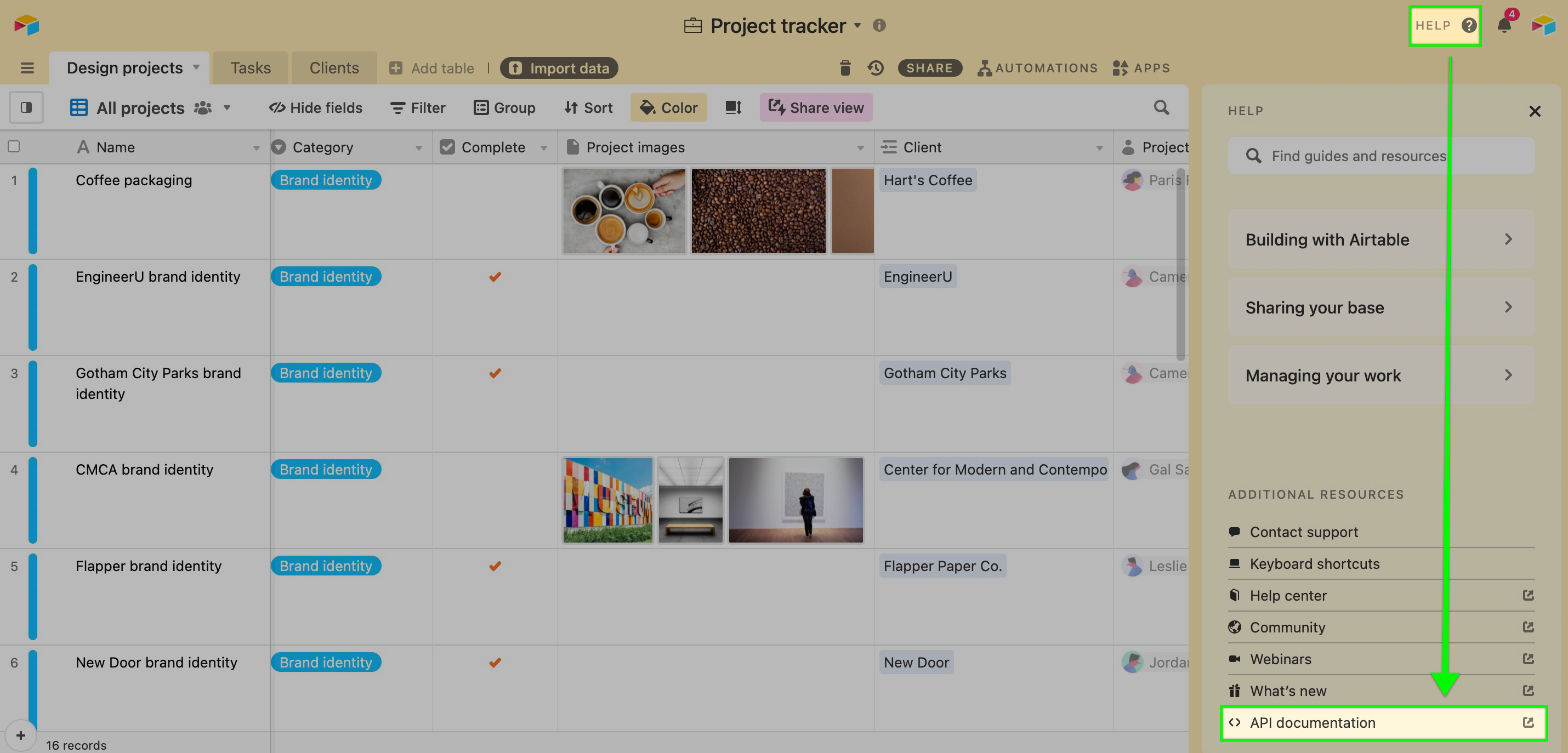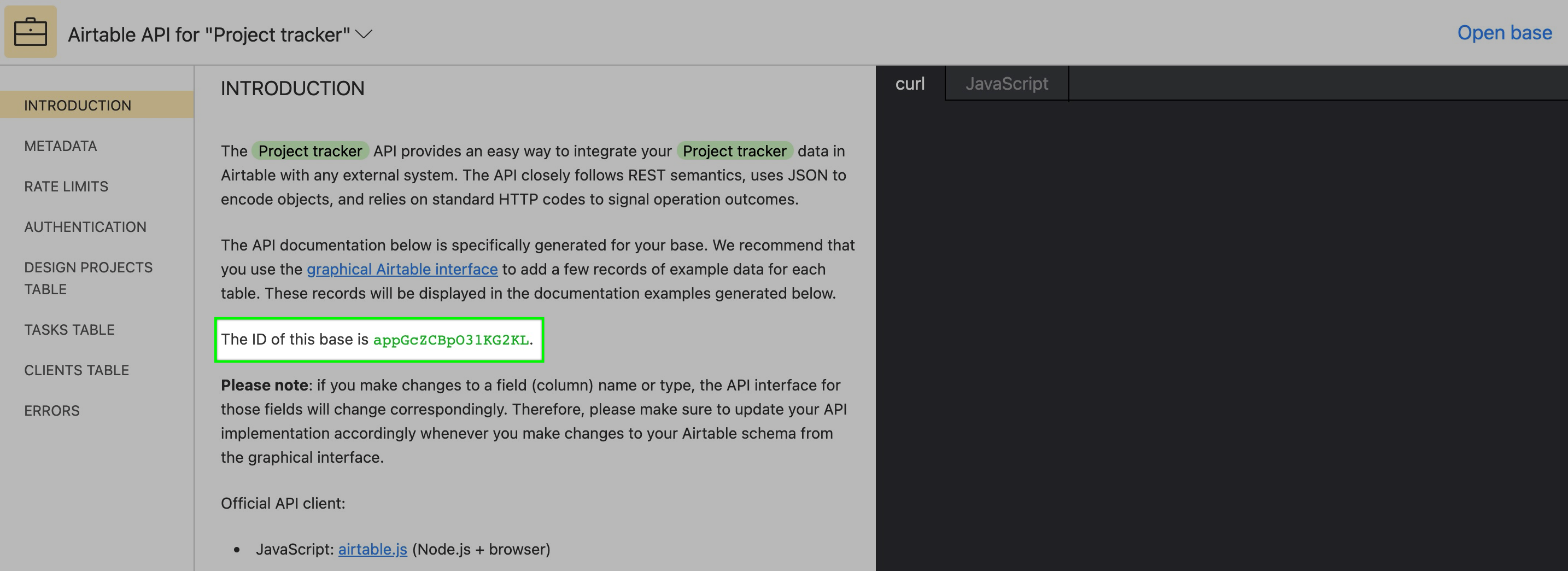All plan types/levels | |
Platform(s) | Web/Browser, Mac app, and Windows app (Add mobile apps if relevant) |
Airtable terminology |
|
In Airtable, there are many IDs that can be helpful to know when looking to share information, automate processes, troubleshoot issues, and more. The article below covers instructions on how to determine the various Airtable IDs that you will come across in the product.
Creating record ID fields
To create a formula field to display record IDs:
Open your Airtable home screen.
Open the base where you want to add a record ID formula field.
Click the + icon to the right of the last column.
Search for and select the “Formula” field type.
Enter
RECORD_ID()into the provided "Formula" window.Click Create field.
Finding record IDs
To find a record ID:
Open your Airtable home screen.
Open the base hosting the record with the ID you want to review.
Locate and expand the record with the record ID you want review.
After expanding your record, a new window opens displaying the record ID.
.png)
Finding field IDs
To find a field ID from a field’s URL:
Open your Airtable home screen.
Open the base hosting the record with the field ID you want to review.
Click the drop down icon next to the name of the field ⌄.
Click Copy field URL.
Paste the field URL to review.
Your field ID is visible at the end of the URL, starting with “fld”
Example: https://airtable.com/appeqX9XTkHZNfSan/tblDdOT3y33CAznBO/viw0Rnv8tdWOdFa89/fldL9Lg62vm58hyH7
To find multiple field IDs:
Open your Airtable home screen.
Open the base hosting the record IDs you want to review.
Click Tools in the upper-right corner.
Click Manage fields.
You’ll now see a list of the the fields and a column for the “Field ID.” If you do not see the “Field ID” column, then click on the column visibility toggle to show the “Field ID” column:

Finding interface IDs
To find an interface URL ID:
Open your Airtable home screen.
Click Interfaces.
Open the interface with the ID you want to review.
The following elements make up the end of an interface URL:
Base ID - Denoted by the prefix
appas noted aboveInterface page ID - Indicated by the prefix
pagExample: https://airtable.com/appiZ2yfX2MMPdBPP/pagBTXwgMb9gjYggM?
To find an interface record detail ID:
Open your Airtable home screen.
Click Interfaces.
Open the interface with the ID you want to review.
Open the record you want to review in a record review interface page or open a record’s detail page.
Copy the URL from the browser bar up until the
=character before the record ID:Record review URLs will be structured like this:
https://airtable.com/appxxxxxxxxxxxx/pagxxxxxxxxxxxx=recxxxxxxxxxxxxRecord detail URLs will be structured like this:
https://airtable.com/appxxxxxxxxxxxx/pagxxxxxxxxxxxxdetail=xxxxxxxxxxxx
In the interface page’s source table, add a formula field that concatenates the link from step 2 and each record’s ID.
The formula will be structured like this:
CONCATENATE("URL link", RECORDID())Please note you'll need to insert the actual interface page link in the formula where you see "URL link" above.
The output is a unique link for each record in the interface being referenced.
Finding Workspace IDs
Note
If your address bar ends with a "?", do not include the question mark character when using or sharing the workspace's ID.
To find a workspace ID:
Open your Airtable account overview.
Select the workspace you want to review from the "All workspaces" menu.
Once your workspace is open, the URL in your browser's address bar will display your workspace ID:
https://airtable.com/workspaces/wspsqMNxxxxxxxxxxxxx?. The text string starting withwspis your workspace ID.
Finding IDs in the admin panel
Note
Only Enterprise Scale and Business plan customers can access IDs from the admin panel. Consult the following admin panel pages to find additional IDs:
Group page - To find group IDs
Workspaces page - To find workspace IDs
Bases page - To find base IDs
Interfaces page - To find interface IDs
Data sets page - To find data set IDs
Account ID
To find your account ID:
Open the admin panel.
Scroll to the section below “Settings” to locate your account ID.
Note
Enterprise hub and super admin permissions are required to access this part of admin panel.
Org unit ID
To find an org unit ID:
Open the admin panel.
Click Organization.
In the “Organizational unit” column, a list of all org units in your Enterprise organization is available. Below each unit’s name, you’ll find its ID.
Finding IDs in the Airtable API
Base IDs
To find a Base ID in the Airtable API, click on the help button near the top-right of your screen. This will open a menu where you will see the "<> API documentation" option.

After clicking the button, you will be brought to our API documentation page that will dynamically surface which base you are working in currently. Both the base name and Base ID will appear.

Field IDs
In our Web API documentation, there is a section called Get base schema where you will find more information about how to identify Field IDs programatically from a specific table. It's worth noting that field IDs can also be gathered manually from the field manager. With the corresponding table open, click Manage fields in the upper right corner. This will open a window where you can find the appropriate field by name and then match that to the ID under Field ID.
FAQs
How do I find multiple field IDs simultaneously:
Open your Airtable home screen.
Open the base hosting the record IDs you want to review.
Click Tools in the upper-right corner.
Click Manage fields.
You’ll now see a list of the the fields and a column for the “Field ID.” If you do not see the “Field ID” column, then click on the column visibility toggle to show the “Field ID” column:
